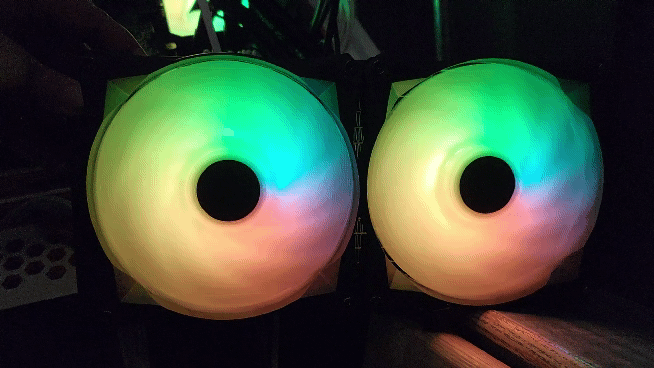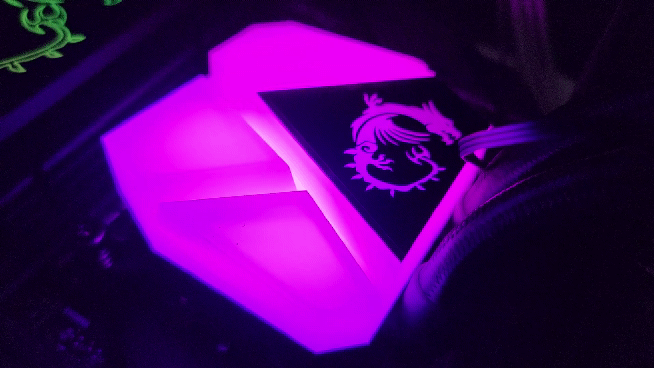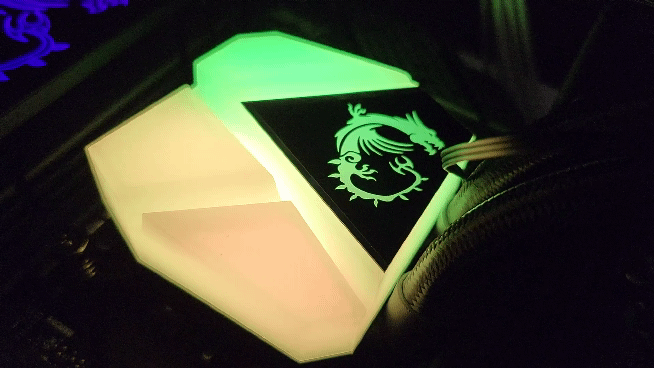MAG Coreliquid C280
The packaging for the Coreliquid C280 is decked out with geometric shapes across a black background and then with a purple geometric filled strip across the middle. The purple strip turns to grey and that actually makes the MAG Coreliquid C280 model name hard to see as well as the information below that which mentions Intel’s LGA 1700 support. The MSI logo on the other hand is in bright white and easy to see in the top left corner as is the mystic light logo which lets you know that this uses MSIs RGB lighting. The front of the box also has a picture of the AIO as well with its RGB fans and RGB blowing top on the waterblock. The back of the box has a picture of the Coreliquid C280 installed in a case with additional matching fans. Then they break down one of the coolers key features, the pump being integrated into the radiator and the radiator having a unique flow layout that pulls water down and back, not just across the radiator to give it more distance to cool down. The end of the packaging also has a full specifications breakdown which is really useful and can help with dimensions if you aren’t sure if this kit will fit though it is mostly the same size as a normal 280mm AIO. Then inside the documentation is up on top with a layer of foam above all of the components which sit in a formed cardboard tray to keep everything from moving.






So the MAG Coreliquid C280 comes with two 140mm fans. They are MSI branded and have the model number APA1425M12. They don’t match any of MSI’s currently listed fans but they do use these in at least some of their cases. So you won’t have the option to pick up more fans to match but you can match if you go with an MSI case. As the back label shows they use a two ball bearing design and the specifications list a 70k hour life expectancy and 78.73 CFM airflow when the fan is running at its max speed of 2000 RPM. The fans have 9 translucent blades with a heavy curve and each blade also has three small grooves cut in them as well. The fan housing is also unique in its shape with a very angular design on every surface. Both fans have the standard four-pin PWM fan header cable as well as a 3 pin ARGB lighting cable. Both have thin black cabling but with twice the cabling it is a lot of wiring that you will need to keep clean.




With most AIO water coolers, the radiator is basically the same with all of them. The MAG Coreliquid C280 on the other hand uses a completely different design. At first glance, it has the same shape and styling but MSI has integrated the pump into the radiator. This helps avoid some overbearing patents for one, but the design does also offer a new spin on the design that isn’t just aesthetic focused. Normal radiator designs are split down the middle but this one has the input on the side and the output in the middle which is where the pump is. I made a color-coded picture to help explain it as well. This does mean that you have to run the 3 pin pump plug to your radiator as well. You can spot the pump by the solid plates on each side. Beyond that, the radiator design has the same boxy style that most AIO coolers have been moving to recently.





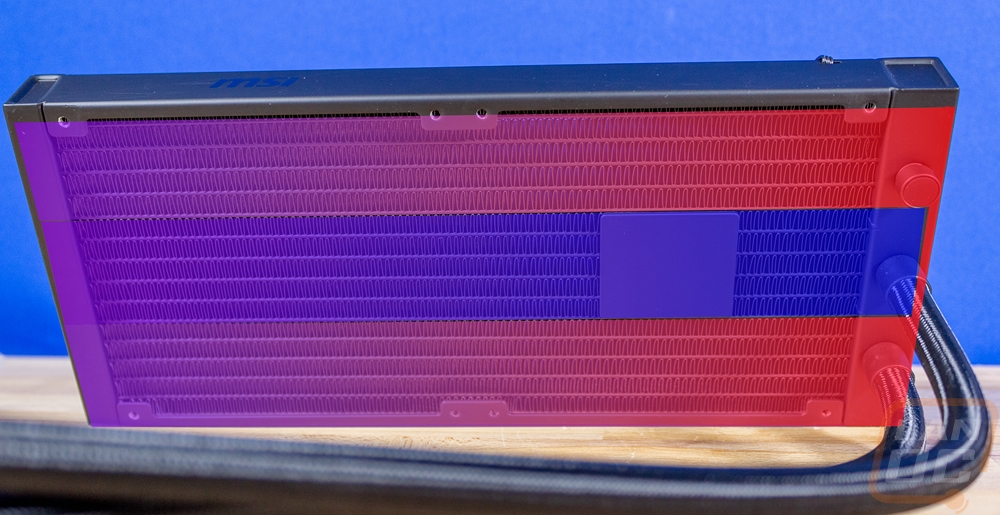
With the pump integrated into the radiator, it means that the water block is just a water block, not a combination of the black and pump like most AIO coolers. This helps the MAG Coreliquid C280 be a little shorter in height, though it is still taller than a standard waterblock. The top portion has the white translucent housing for the addressable RGB lighting and they have molded into it geometric designs with one corner having a black section with the MSI gaming dragon logo. The two water lines come in on the right side and have a plastic 90 right at the pump that swivels to help get your lines aimed where you need them. The bottom of the block has a copper finish on the contact surface. The surface itself isn’t a full mirror finish like a custom loop water block would have, but it is a LOT better than the brushed finish that a lot of AIO coolers get. Then for cables, because of the addressable RGB lighting, the block does have a cable coming out with the lighting plug that goes into your motherboard and a second in line that you can use on the fans if you want to hook them up altogether.





The MAG Coreliquid C280 does come with a few loose accessories when you dig into it. The fans themselves also come loose, but I have already touched on those. You get a bag of mounting hardware for the new LGA1700 socket which I obviously used for the Z690 review. There are two top mounts for the waterblock, one for Intel and the other for AMD and the Intel top bracket works with the 1700 socket. Then there is a second backplate for older Intel sockets. The AMD mounting design uses the stock plastic hook design from AMD so there isn’t a backplate needed for that. You get a fan splitter to hook both fans up to one PWM fan header so they have matching fan speeds and there is also a Molex to fan header adapter if you want the fans running at full speed all of the time and don’t have a motherboard header open. Thermal paste is included in a small dispenser as well. Then you have three small bags of mounting hardware. The one on the right in the picture below is all fan screws with short and long mounting screws for the fan and the radiator to be mounted. There is a bag just for Intel LGA2011 mounting with its screw-in standoffs. Then the last bag has all of the standard mounting including the screw-down thumbnuts with integrated springs.


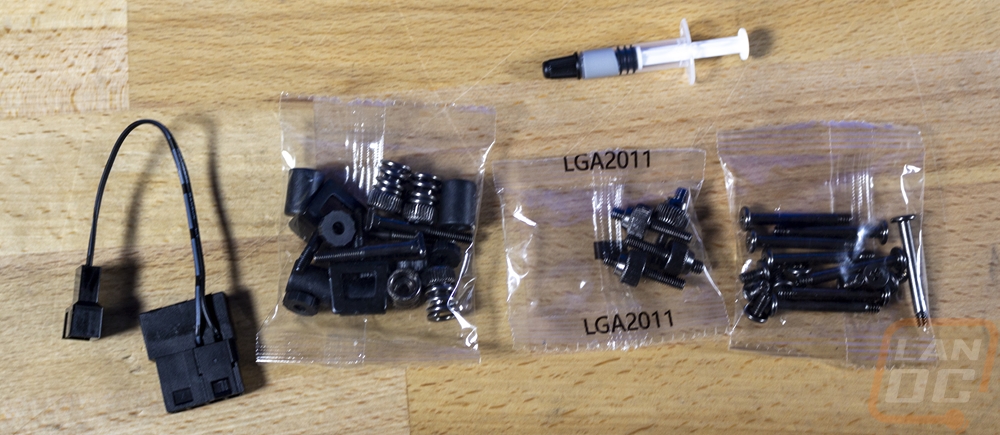
As for the lighting on the Coreliquid C280, I did get a few pictures of both the pump/block and of the fans when running. I especially like the look of the waterblocks lighting with the addressable RGB lighting behind the translucent top housing. The white translucent blades on the fans have a similar effect as well that does a great job of blending the lighting while the fans are running.







I also got a few videos of the lighting effects as well. Keep in mind that the lighting effects are run off of your motherboard's controls, so the effects available will depend on the options that the software has.
